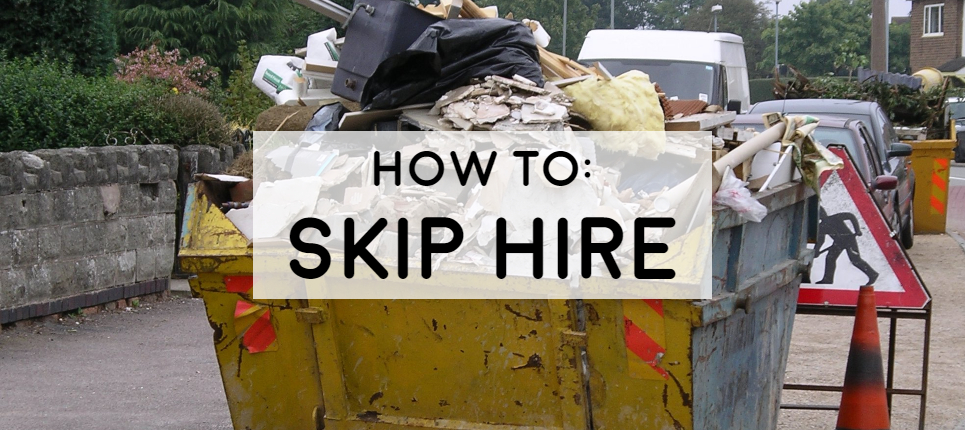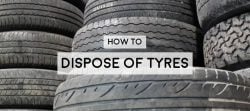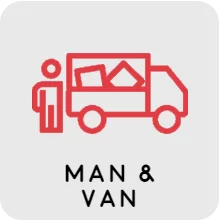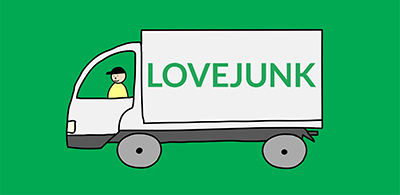Skip Hire Guide for Beginners
Hiring a skip can be quite daunting if you haven’t done it before. Everyone seems to assume you already know how it works and what you need.
Talk of ‘cubic yards’, ‘builders skips’ and other jargon can make the average skip hire newbie feel a bit at sea. To help make it all a bit easier, here is our Skip hire guide for beginners.
- Waste types – what can I put in a skip?
- Skip size – what size skip is best to hire?
- Skip hire cost – how much should I expect to pay for skip hire?
- Skip permits – what is a skip permit or skip license?
- CPZ suspension – what is a CPZ suspension fee?
- Materials – what type of skips are suited for what materials?
- Labour – do skip hire companies help load the waste into the skip?
- Wait and load – what is a wait & load service?
- Duration & collection – how long can I hire a skip for and when is it collected?
- Access restrictions – what are the access requirements for a skip lorry?
- Weight restrictions – how much weight can I put in a skip?
- Skip Hire Level Loads – how high can I load a skip?
- Driveway protection – how do I protect my driveway from damage by a skip?
- Lights and covers – council safety restrictions on skips
- Paperwork – what paperwork should I expect?
- When to use a skip for waste removal and when it’s not the best option
- Disposal & recycling – where does the waste go?
The easiest answer to what can be put in a skip is to list what cannot be put in a skip. Here are the most common items that cannot be disposed of in a skip:
- Asbestos
- Batteries
- Clinical or medical waste, including syringes
- Electrical appliances & equipment
- Fluorescent tubes
- Fridges, freezers and air conditioning units
- Gas canisters and gas bottles
- Hazardous & toxic materials
- Liquids
- Oil, petrol, diesel
- Paint & Cans of paint
- Plasterboard
- Tyres
- TVs & computer screens
Beware that if any prohibited items are found when the skip is emptied you are likely to be charged extra and the restricted items returned to you. We advise that you keep an eye on your skip if it’s in an open and public area because people could put their own rubbish in your skip. If this happens, unfortunately you are responsible for the waste that is in your skip.
The ideal size of skip depends on the amount of waste and how much space you have to put the skip. The larger the skip, the cheaper it works out per cubic yard/metre of waste removed. But make sure you have enough waste to fill it, otherwise, you’ll end up paying for thin air. Also, bear in mind most councils do not allow skips larger than 8 yards to be placed on a public highway.
The skip size volume photos and descriptions in our Booking Funnel will help you choose the most appropriate skip size. Additional guidance on skip sizes can be found in our Skip Size Guide or if you would prefer to chat through your requirements, call our customer service team on 020 7819 9000.
Skip prices differ substantially due to a range of factors including size of skip (larger ones cost more), geography (typically the South is more expensive than the North based on higher costs of disposal and operation), and whether or not you require a skip permit (i.e. if the skip is located on or off-road).
The national average price for an off-road 8-yard skip is around £250 (£300 including VAT). Average price data across the UK can be on our national skip prices page.
Bear in mind that hiring a skip (before any permit fee) typically costs around 20%-25% more than having the waste removed by a man & van, unless you are getting rid of lots of very heavy dense materials like rubble and soil. This is because a man & van only need to visit your site once, whereas skip lorries come twice – once to deliver and once to collect. So, unless you have lots of heavy, messy waste that needs to be contained, it will normally be cheaper and quicker using a man and van clearance service.
If you put a skip on a public highway (often referred to as an ‘on-road skip’) rather than private land, you will need a skip hire permit from the council. This has to be organised before the delivery of the skip. Skip permits (or skip licenses) cost extra and take a few days to arrange. We organise the permit for – so it’s not and, if it’s in a controlled parking zone (ie. on a single yellow line or in a resident’s parking or pay & display bay), you will also need a parking suspension. Both cost money and take at least a few days to arrange.
For more information on skip permits and prices, visit our skip permit guide.
A controlled parking zone (CPZ) is a part of a road where you can only park under certain conditions. For example, it requires a residents’ parking permit, is a pay & display bay, or yellow lines. CPZs apply to skips too. So, if you are planning on locating a skip in a CPZ, you will need a CPZ suspension in addition to any skip permit. These add to the cost of your skip hire. Normally your skip hire company will sort it out for you.
As a householder you will almost always be ordering a Mixed Waste skip, rather than an Inert Waste skip. This is because you will getting rid of a broad mix of waste materials. That is why when you ask a skip company for a price, they will always quote you the mixed waste skip price first. However, if you ONLY have Inert Waste to dispose of, then you should ask the skip company for an Inert Waste skip because this will be cheaper. Inert Waste is waste from demolition and construction work like rubble, soil, sand and cement. In other words the sort of stuff you get from a basement conversion or landscaping job. Inert waste does not decompose – it just ‘is’ – so can be disposed of differently to general mixed waste, including reused in other construction projects. Mixed waste can be anything from builders waste, bulky appliances (including domestic fridges), furniture, mattresses, carpet, plasterboard, garden waste and household junk. Inert waste skips cost less than general waste skips – but in practise tend to be ordered by building companies and tradesmen rather than householders.
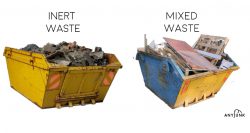
The skip hire service covers the delivery and removal of the skip, not any labour to load it. If you require help filling the skip then you may prefer a man & van clearance service instead, or alternatively, a wait and load skip service.
A wait and load service is when the skip is delivered but the skip lorry waits while you load it and then takes it away immediately. This is a great option if your waste is ready to go and space is a premium. The difference between this and a man & van rubbish clearance service is that the latter includes the loading, whereas with a ‘wait & load’, the skip driver just waits in the cab as you do all the work.
The price of a skip normally covers hire for up to 2 weeks. Collection date is flexible. You can either specify when you want the skip collected at the time of hire, or request a collection later once you know a bit more. Skip companies generally collect within a couple of days of request – so if it’s important the skip is gone by a certain date, then be sure to give them a reasonable amount of notice.
If you need a skip for longer than two weeks, then just ask the skip company when you book. They may charge extra or they may just say agree to extend the hire for no additional cost. In truth, it doesn’t exactly cost the skip company anything to have the skip at your property a few days longer, unless they’ve actually run out of skips back at their yard and are turning away business! That said, if the skip is being placed on a street, bear in mind you will need to extend your skip permit and any parking suspension. Both cost money, so longer hire periods, may lead to extra charges regardless.
Skips are normally delivered on large 7.5-tonne HGV lorries that are wider than a car. Make sure there is enough space for the skip lorry to access the place you want the skip to be located or consider changing the location. If road or gate access is narrow, check with your skip hire company beforehand that the dimensions of the lorry will fit.
Weight restrictions do apply to skips but these limits are rarely an issue for householders. This is because householders (unlike builders or landscape gardeners) don’t tend to fill skips with loads of really heavy waste, like soil and rubble. The table below gives a rough guide to weight limits –although these do vary quite a bit by skip company. However, unless you are planning on hiring a skip that is bigger than 8 cubic yards and filling it entirely with soil, bricks, sand or rubble, it is very unlikely to be an issue.
| Skip size | Bin bags | Max weight |
| 2 Yard | 15-20 | 2 Tonnes |
| 4 Yard | 30-40 | 4 Tonnes |
| 6 Yard | 50-60 | 6 Tonnes |
| 8 Yard | 60-80 | 8 Tonnes |
| 10 Yard | 80-100 | 8 Tonnes |
| 12 Yard | 100-120 | 8 Tonnes |
Most skips have the expression ‘Level Loads only’ clearly written on the side and the terms and conditions of skip hire will also specify the same. This means you should never fill your skip above the height of its sides. If you exceed this height then you risk the skip lorry driver refusing to collect your skip or asking you to empty out all the extra stuff before he removes it. This is because overloaded skips are dangerous to transport since stuff could fall out on route and cause damage or injury to others.
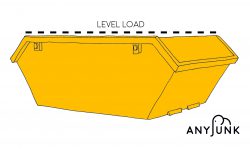
Driveways made with soft tarmac or block paving have the potential to be damaged by skips. This can easily be avoided by placing scaffolding planks or big pieces of wood to rest the skip. Bear in mind also that skip lorries are heavy and when they take away your filled skip, they are even heavier. Skip lorries use stabilisers when they load the skip. These metal legs exert significant pressure on the ground and can dent soft tarmac or break paving stones. If you are concerned about damage to your drive, always speak to the skip provider first for their advice on how to protect it.
There are a few safety rules applying to skips. You may need to have safety lights/coverings on the skip. The rules vary depending on where you are in the UK, so it’s best to contact your local council to find out, however, the vast majority require you to have lights and a cover overnight. Any decent skip supplier will advise you on what your skip will need in order to be safe. Most skip suppliers will pay for the lights and covers on the skips but others make it the customer’s responsibility. If that’s the case, you can purchase skip lights and covers in stores such as Screwfix, or online on websites like Amazon. A sheet of tarpaulin or something similar can be used as a skip cover.
Be wary of any skip companies that don’t advise you because if the skip is on a public highway and doesn’t follow the councils safety regulations you could be fined up to £1000. If it’s on private property, the rules don’t apply.

The skip hire company should provide you with a delivery ticket when they drop off the skip and then, when they remove it, a waste transfer note. The waste transfer note will have your information, details of the waste, the date, and the skip company’s information.
Provided you have space to put it on at your property, a skip is ideal for messy, heavy waste that you are creating over a period of days. For example, replacing your old bathroom or redesigning your garden. It contains the waste nicely and keeps your drive or garden free from lots of small bits of waste. Also, unlike a man & van rubbish clearance, weight is rarely an issue with skips so you won’t need to worry about vehicle overloading or being charged extra if you have lots of rubble, paving stones, bricks or soil.
The main negatives with a skip is that the size is fixed (meaning you’ll normally end up paying for some thin air or having to order another one, whereas with a man & van clearance they can just amend the size on the day and charge you a bit more or less); you have to do all the loading yourself; you cannot put appliances in a skip; and a skip is expensive compared to man & van clearance, especially if you need to have to get a skip permit or CPZ suspension. Plus neighbours can have a habit of filling it up overnight when you’re not watching!
Once collected, the skip will be taken to a licensed commercial waste transfer station. At the transfer station the waste is unloaded and sorted. Depending on the waste types, where the transfer station is in the UK and its sorting equipment, the material will either be recycled, sent to a waste to energy facility, taken to a landfill site or a combination of all three.
Other resources
If you found this guide helpful, you might like some of our others:
- Bulky Waste Disposal and Coronavirus Advice
- 10 great ways to cut the cost of skip hire
- Skip size guide
- Skip permit guide
- Man & van rubbish clearance guide
- Top tips to cut the cost of bulky rubbish clearance
- Skip bag guide
- Bulky waste disposal guide for householders





